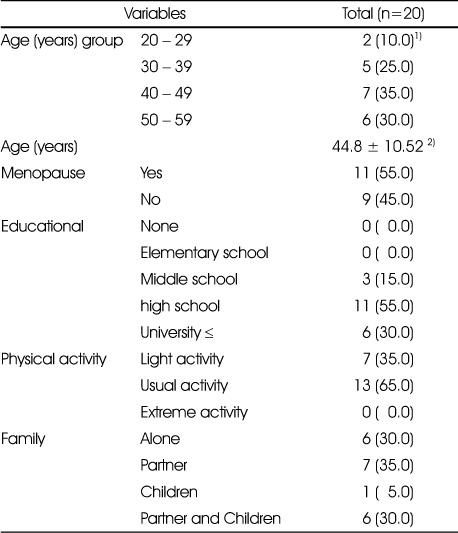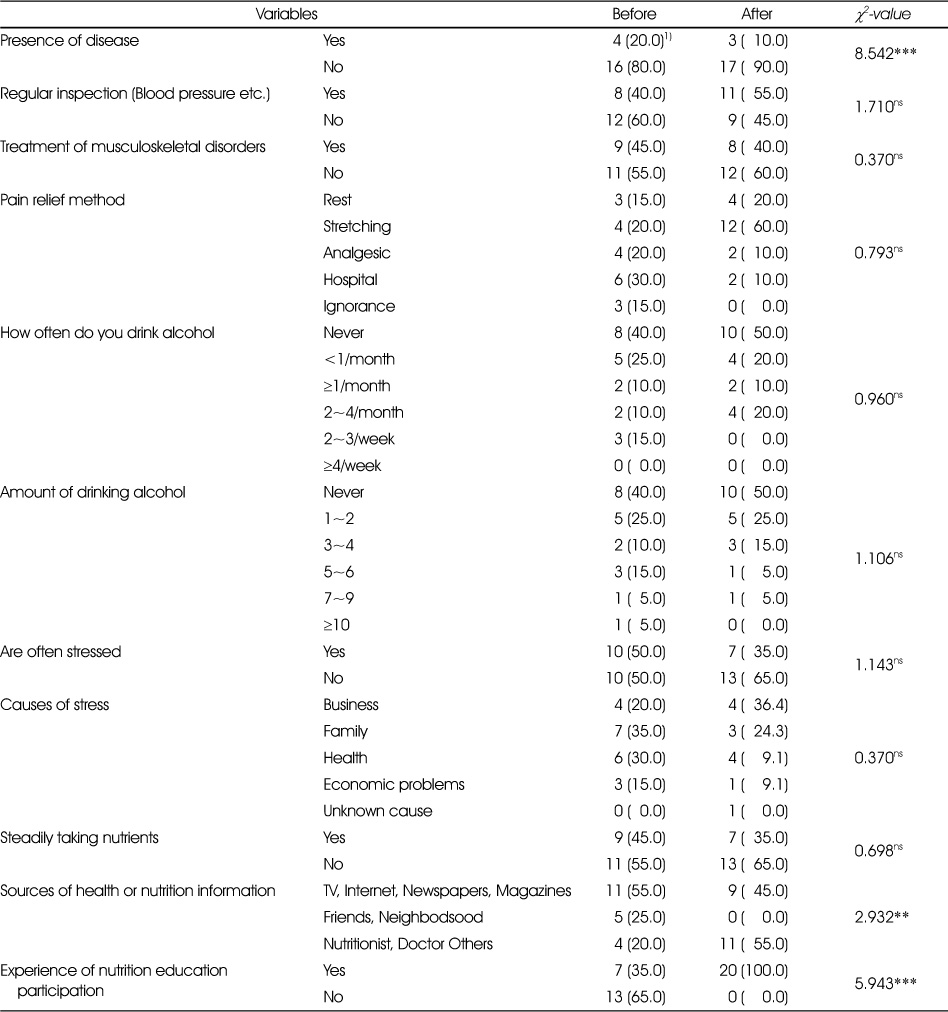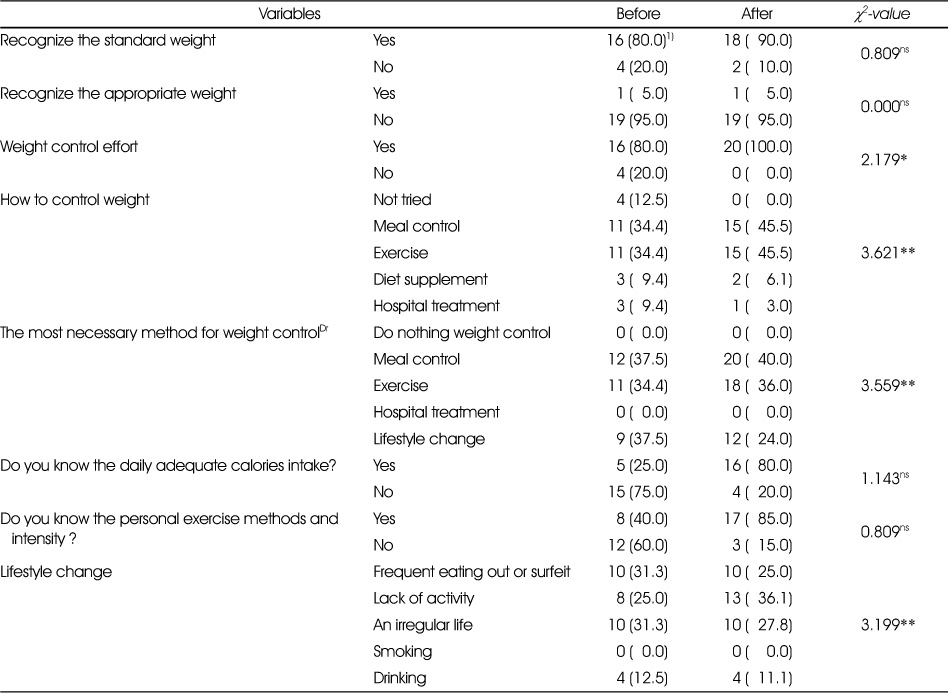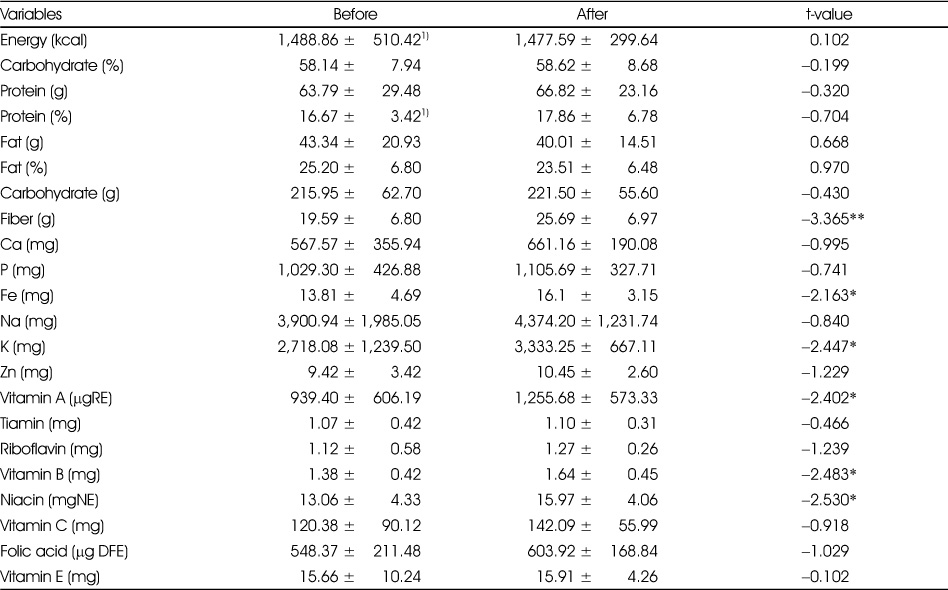Articles
- Page Path
- HOME > Korean J Community Nutr > Volume 23(4); 2018 > Article
-
Research Article
- Effects of Nutrition Education and Exercise Program on Obesity Index and Behavioral Modification in Moderate Obese Women
-
Myung-Hee Chang, Su-Jin Jung

-
Korean Journal of Community Nutrition 2018;23(4):318-332.
DOI: https://doi.org/10.5720/kjcn.2018.23.4.318
Published online: August 31, 2018
1Jeonju Health Center, Jeollagamyeong-ro 33, Jeonju 54907, Korea.
2Clinical Trial Center for Functional Foods, Chonbuk National University Hospital, Jeonju 54907, Korea.
- Corresponding author: Su-Jin Jung. Clinical Trial Center for Functional Foods, Chonbuk National University Hospital, Jeonju 54907, Korea. Tel: (063) 259-3044, Fax: (063) 259-3060, sjjeong@jbctc.org
Copyright © 2018 The Korean Society of Community Nutrition
This is an Open-Access article distributed under the terms of the Creative Commons Attribution Non-Commercial License (http://creativecommons.org/licenses/by-nc/3.0/) which permits unrestricted non-commercial use, distribution, and reproduction in any medium, provided the original work is properly cited.
- 521 Views
- 3 Download
- 3 Crossref
Abstract
-
Objectives
- The purpose of this study was to investigate the behavioral modification of obese adults who underwent nutritional and physical activity education. Twenty obese females, aged 20–60 years old, with BMIs (Body Mass Index) >30 or body fat (%) >40 were subjected to this study.
-
Methods
- The physical activity education program consisted of doing exercise in a gymnasium together or home exercise. Dietary attitudes and dietary intakes were assessed using weight control, physical activity, and eating habits. The nutrition-exercise educational period was 12 weeks.
-
Results
- After the study period, there was significant improvement in physical activity and eating habits score. Furthermore, there was a significant increase in the dietary intakes of fiber, iron, potassium, vitamin A, vitamin B6, and niacin. Blood pressure, blood glucose, and total cholesterol levels showed a tendency to decrease, but there was no significant difference. BMI, fat mass, abdominal circumference, and visceral fat levels were significantly reduced while muscle mass significantly increased.
-
Conclusions
- This study suggests that behavioral modification by nutrition and physical activity education with feedback has positive effects on dietary intake and anthropometric biomarkers in obese adults. Therefore, lifestyle interventions of this kind could be recommended as a method for obesity management.
- 1. Jeon ER. Effect of nutrition education and aerobic exercise program on weight control in program of middle aged abdominal obesity women. Korean J Hum Ecol 2006; 9(2): 65-73.
- 2. Ha AW, Ryu HS. Patterns of food habits and food intake by age: Base on the nutrition counseling data of medical health examination. Korean J Food Nutr 2010; 23(4): 531-541.
- 3. Whitmer RA, Gunderson EP, Barrett-Connor E, Quesenberry CP, Yaffe K. Obesity in middle age and future risk of dementia: a 27 year longitudinal population based study. BMJ 2005; 330(7504): 1360-1362.ArticlePubMedPMC
- 4. Layman DK, Evans E, Baum JI, Seyler J, Erickson DJ, Boileau RA. Dietary protein and exercise have additive effects on body composition during weight loss in adult women. J Nutr 2005; 135(8): 1903-1910.ArticlePubMed
- 5. Varady KA, Lamarche B, Santos S, Demonty I, Charest A, Jones PJ. Effect of weight loss resulting from a combined low-fat diet/ exercise regimen on low-density lipoprotein particle size and distribution in obese women. Metabolism 2006; 55(10): 1302-1307.ArticlePubMed
- 6. Andersson K, Karlstrom B, Freden S, Petersson H, Ohvall M, Zethelius B. A two-year clinical lifestyle intervention program for weight loss in obesity. Food Nutr Res 2008; 52(10): 1656.Article
- 7. Lee O, Kim J, Lee H, Choue R. Nutritional status, quality of diet and quality of life postmenopausal women with mild climacteric symptoms based on food group intake patterns. Korean J Community Nutr 2012; 17(1): 69-80.Article
- 8. Choi JH, Yang JH, Han JP. A comparative analysis of body composition and blood lipid profile during exercise and detraining in exercise type in the middle-aged obese women. Korean J Phys Educ 2006; 45(3): 526-536.
- 9. Garrow JS. Obesity and obesity related a disease. Edinburgh: Churchill Livingstone; 1988. p. 12-14.
- 10. Lee KW, Lee Y, Oh YJ, Cho YJ, Lee MJ. Attitudes toward family meals and comparisons of dietary quality between family meals eaten alone in middle and high school students. J Korean Diet Assoc 2008; 14(2): 127-138.
- 11. Kim SY, Kim SB. Effects of nutrition education at a community health center on overweight and obese middle aged women in Jeonbuk area: focused on personalized daily energy requirement and food exchange units. Korean J Community Nutr 2017; 22(4): 307-322.ArticlePDF
- 12. Lee JW, Yoo SY, Yang SY, Kim H, Cho SK. Effect of an abdominal obesity management on dietary intake, stress index, and waist to hip ratio in abdominally obese women: Focus on comparison of the WHR decrease and WHR increase groups. Korean J Nutr 2012; 45(2): 127-139.Article
- 13. Choi MS, Kim MS. The effect of nutritional education and exercise intervention on reducing weight of obese women. Korean J Community Living Sci 2006; 17(4): 57-66.
- 14. Lee HS, Lee JW, Chang N, Kim JM. The effect of nutrition education and exercise program on body composition and dietary intake, blood lipid and physical fitness in obese women. Korean J Nutr 2009; 42(8): 759-769.Article
- 15. Kim KD, Song YO, Baek YH. Effects of belly dancing and nutritional education composition and serum lipids profiles of obese women in a study, obesity clinic projects at community healthcare. J Korean Soc Food Sci Nutr 2011; 40(10): 1417-1422.
- 16. Kim YH, Kang SH, Kim YS, Song JI, Lee DC, Jeon SH, et al. Development of training program for managing obesity and its effects on the application of program. Phys Educ Res Inst 2000; 11(1): 20-48.
- 17. Yu BK. The change of severely obese middle women's body fat, cardiovascular strength and blood hormone on the combined exercise. J Exerc Nutr Biochem 2005; 9(3): 253-259.
- 18. Kang EJ. Educational attainment and subjective unhealthiness an exploration of the mediators. Korean J Health Econ 2008; 14(1): 51-74.
- 19. Lee YA, Kim KN, Chang N. The effect of nutrition education on weight control and diet quality in middle-aged women. Korean J Nutr 2008; 41(1): 54-64.
- 20. Lee HS, Lee JW, Chang N, Kim JM. The effect of nutrition education and excercise program on body composition and dietary intakes, blood lipid and physical fitness in obese women. Korean J Nutr 2009; 42(8): 759-769.Article
- 21. Kim MY, Han SY, Jeong JH, Kim SH, Lee JK, Park ES, et al. Effectiveness of nutrition-exercise education program on weight control of adult women. Korean J Community Nutr 2009; 14(2): 168-174.
- 22. Oh JY, Kim SB. Development and effects analysis of nutrition education program for diabetes mellitus at community health center: focused on individual daily energy requirements and food exchange units. Korean J Community Nutr 2010; 14(4): 485-497.
- 23. Heo S. Effects of behavior modification for complex exercise and nutrition education providing feedback on metabolic syndrome related factors, adipocytokine and dietary intakes in obese high school girls. Korean J Phys Educ 2012; 51(2): 441-451.
- 24. Choi IH, Lee MW. The effects of a 12 week walking exercise program on the body composition and physical fitness in obese college women. J Korean Acad Public Health Nurs 2008; 22(1): 74-83.
- 25. Kang YH, Yi KO, Ha EH, Kim JY, Kim WY. Evaluation of short term weight control program for female college students. Korean J Nutr 2004; 37(6): 493-501.
- 26. Duncan CS, Blimkie CJ, Cowell CT, Burke ST, Briody JN, Howman Giles R. Bone mineral density in adolescent female athletes: relationship to exercise type and muscle strength. Med Sci Sports Exerc 2002; 34(2): 286-294.ArticlePubMed
- 27. Lutes LD, Winett RA, Baeger SD, Wojcik JR, Herbert WG, Nickols-Richardson SM, et al. Small changes in nutrition and physical activity promote weight loss and maintenance: 3-month evidence from the ASPIRE randomized trial. Ann Behav Med 2008; 35(3): 351-357.ArticlePubMed
- 28. Kim JD, Ye SR, Kim TK, Sun WS. The effect of Hula-hoop exercise on body composition and physical fitness of obese women. J Phys Growth Motor Dev 2006; 14(3): 27-38.
- 29. Ha CS. The effect of gradual load method exercise program on body composition and physical fitness in obese fitness women. Korean J Sports Sci 2004; 13(2): 757-766.
- 30. Kim TY, Han DB, Ahn JH, Lee SH. Effect of mothers' identification on nutrition labeling to children's obesity. Korean J Health Econ Policy 2013; 19(3): 51-82.
- 31. Nam JH. Effect of weight control program on obesity degree and blood lipid levels among middle aged obese women. Korean J Food Nutr 2006; 19(1): 70-78.
- 32. Kim NH, Kim JM, Kim H, Chang N. Effects of nutrition and exercise education in fat mass and blood lipid profiles in postmenopausal obese women. Korean J Nutr 2007; 40(2): 162-171.
- 33. Colak R. Effects of short-period exercise training and orlistat therapy on body composition and maximal power production capacity in obese patients. Physiol Res 2004; 53(1): 53-60.ArticlePubMed
- 34. Shin YA, Kim HJ. The effects of long-term aerobic and resistance combined exercise training on cardiovascular risk factors and oxidative stress in stroke patients. Exerc Sci 2010; 19(3): 231-246.Article
REFERENCES
Figure & Data
REFERENCES
Citations

- Effect of tele-nutrition education on weight loss, energy intake, and fat adequacy among obese adults in Banyumas, Central Java, Indonesia
Teguh Jati Prasetyo, Izzati Nur Khoiriani, Sifa Aulia Wicaksari, Gumintang Ratna Ramadhan, A. Khomsan, E. Palupi, S.P. Loh, N. Mohd Esa
BIO Web of Conferences.2025; 153: 02013. CrossRef - Influence of Comprehensive Lifestyle Intervention (LSI) Program on Health, Fatigue, and Quality of Life in Middle-Aged Women
Su-Jin Jung, Seung-Ok Lee, Min-Jun Choi, Jun Heo, Soo-Wan Chae, Baik-Hwan Cho
Journal of Lifestyle Medicine.2022; 12(3): 127. CrossRef - Effect of Nutrition Counseling by Nutrition Care Process on Diet Therapy Practice and Glycemic Control in Type 2 Diabetic Patients
Tae-Jeong Bae, Na-Eun Jeon, Soo-Kyong Choi, Jung-Sook Seo
Korean Journal of Community Nutrition.2020; 25(3): 214. CrossRef
Contents on obesity management program
General characteristics of subjects
1) Values are expressed as frequency (%)
2) Values are mean ± SD
Characteristics of health in subjects before and after the intervention
1) Value N (%)
2) NS: Not significant 3) *: p< 0.05, **: p< 0.01, ***: p< 0.001 : significant different at analyzed using χ2-test.
Comparison of weight control interest in subjects before and after the intervention
1) Value N (%)
2) NS: Not significant 3) *: p< 0.05, **: p< 0.01, ***: p< 0.001 : significant different at Analyzed using χ2-test.
Physical activity assessment in subjects before and after the intervention
1) Values is are Mean ± SD
2) Point type scale (①: not performed at all “1” ~ ⑤: performed very well “5”)
*: p< 0.05, **: p< 0.01, ***: p< 0.001, respectively by paired t-test.
Eating habits in subjects before and after the intervention
1) Values is are Mean ± SD
2) *: p< 0.05, **: p< 0.01, ***: p< 0.001, respectively by paired t-test.
Characteristics of anthropometry in subjects before and after the intervention
1) Values is are Mean ± SD
*: p< 0.05, **: p< 0.01, ***: p< 0.001, respectively by paired t-test.
Characteristics of blood pressure and biochemical in subjects before and after the intervention
1) Values are presented as N (%), significant different at analyzed using χ2-test.
2) Values are mean ± SD by paired t-test.
NS: not significant
Energy and nutrient intakes in subjects before and after the intervention
1) Values is are Mean ± SD
*: p< 0.05, **: p< 0.01, ***: p< 0.001, respectively by paired t-test.
1) Values are expressed as frequency (%) 2) Values are mean ± SD
1) Value N (%) 2) NS: Not significant 3) *: p< 0.05, **: p< 0.01, ***: p< 0.001 : significant different at analyzed using χ2-test.
1) Value N (%) 2) NS: Not significant 3) *: p< 0.05, **: p< 0.01, ***: p< 0.001 : significant different at Analyzed using χ2-test.
1) Values is are Mean ± SD 2) Point type scale (①: not performed at all “1” ~ ⑤: performed very well “5”) *: p< 0.05, **: p< 0.01, ***: p< 0.001, respectively by paired t-test.
1) Values is are Mean ± SD 2) *: p< 0.05, **: p< 0.01, ***: p< 0.001, respectively by paired t-test.
1) Values is are Mean ± SD *: p< 0.05, **: p< 0.01, ***: p< 0.001, respectively by paired t-test.
1) Values are presented as N (%), significant different at analyzed using χ2-test. 2) Values are mean ± SD by paired t-test. NS: not significant
1) Values is are Mean ± SD *: p< 0.05, **: p< 0.01, ***: p< 0.001, respectively by paired t-test.

 KSCN
KSCN









 PubReader
PubReader Cite
Cite


